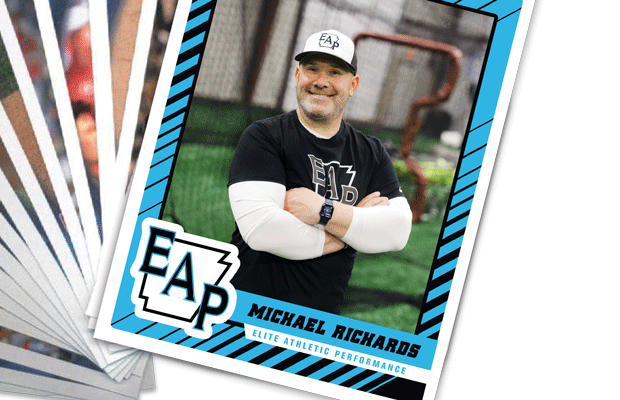Elite Athletic Performance

Like many, Michael Richards played baseball as a boy. “We weren’t great,” he says. “We were playing the best team in the league.” It was at this moment that his most vivid memory of his youth occurred.
His father, Randy Richards, was the team coach. What came next shaped not only Michael’s immediate actions, but also his current business.
“He (Randy) took out a dollar bill and said, ‘How good they (the other team) are doesn’t matter if y’all are only going to give this much effort.’ And he tore the dollar bill in half. Obviously that got a bunch of third graders’ attention. We went out and won that game. I think about that all the time.”
The philosophy that great results require great effort stuck with Michael. In the late 2000s, he put his own plan into action with that same high level of effort.
“I saw an underserved population of athletes who weren’t taking advantage of knowing how to train properly.” Michael says. “I also noticed traditional coaching cues given to players, particularly pitchers, just weren’t actually happening. It bothered me that as long as a positive result happened, people assumed the cue or drill ‘worked.’ This was my chance to make it better, or find out if I was wrong.”
He opened Elite Athletic Performance, LLC. (EAP), currently located at 405 Randel Drive in Benton.
“We start at about age 11 and continue until they do not have a uniform to wear anymore,” he says. “We use what we call Foundations 1 and Foundations 2. These are programs I designed to prepare our younger athletes for our full program.”
EAP offers training in skills such as batting, pitching, and base running. “There is quite a bit of research suggesting that verbal cues are typically the most inefficient way to impact movement patterns,” he says. “For that reason, we don’t do a lot of traditional ‘lessons.’ If we feel personal, private lessons are the best plan for a particular athlete, then by all means we have coaches who can do it. But for our hitters, we typically use tools to manipulate the situations in which our hitters are hitting. Eye Patches, heavy bats, heavy balls, small bats, long bats, light manipulation, etc. We call them ‘Hostile Hitting Environments.’
“For our pitchers, we utilize a very slow motion camera to find what we call the ‘lowest hanging fruit’ in their delivery. This refers to the things that we can attack with what we call ‘Muscle Memory’ work and ‘Med Ball’ work from the mound. This is how our pitchers can train to better their delivery every day without the stress of actually pitching every day. This is not an easy process because it is best when the work is explained to the athlete, he understands it, and is able to ‘zone out’ while being left alone and supervised from a distance. He is working to create new, repeatable movements through tons of highly focused repetitions.”
EAP offers conditioning training that translates into specific benefits to baseball.
“Our programming is highly focused on making the athlete as explosive from a movement standpoint as possible. For our older athletes that have plenty of weight room experience, we use what I would explain as a systematic formula of heavy and light loads, lifted at different speeds and intensities at different points of the program, combined with explosive jumps and medicine ball throws that work in harmony with each other to create incredibly strong, mobile, explosive athletes. The vast majority of baseball happens in bursts of less than a second, so that is where our focus lies.”
Michael says he understands the pace of modern life as it pertains to year-round training. “To be honest, that is what I refer to as a ‘best-case/worst-case’ situation. Best-case scenario, everyone trains in some capacity all year. But kids are pulled in way too many directions these days. So we do our best to get as close to ‘Best Case’ as possible and stay away from ‘Worst Case’ as much as possible. Every situation is different. Some athletes don’t miss a beat in-season. Some do not come at all. I understand both. We make needed adjustments for in-season athletes and keep rolling.
“I view us as ‘bucket fillers’. In order to be as well rounded as possible, athletes need to have as many metaphorical buckets, carrying as much metaphorical liquid, as possible. The buckets represent athleticism, strength, speed, flexibility, etc. We assess which buckets aren’t getting filled, and get to work.”
To the parents of youngsters with dreams of going far in baseball, he offers the following advice. “Let them dream. Don’t let a coach tell them it’s not possible, but remind them, you cannot accomplish abnormal goals while behaving like a normal person. High achievers are not normal.”
Michael says, “At last count we have roughly 120 athletes who have gone on to play sports at the collegiate level over the last eight to ten years. I’d say approximately 100 of those are baseball players. Of those 120, I’d guess approximately fifty to sixty percent were from Saline County. All totaled we’ve had nine professional contracts signed by our athletes.
“This offseason we’ve had five professional players training with us in some capacity: Logan Allen (Bryant HS/UA-Fort Smith/Tampa Bay Rays); Evan Lee (Bryant HS/Arkansas/Washington Nationals); Ross Carver (Benton HS/Crowder CC/DBU/Arizona Diamondbacks); Jordan Wix (Conway HS/Kansas State/Chicago Cubs); and Nick Starr (Conway HS/Connors State/SAU/Texas Rangers). We also have an athlete named Taylor Langston who recently graduated from Henderson State University and is training to earn an opportunity in pro ball.”










0 comments